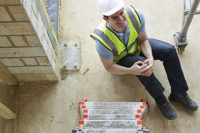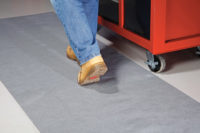It seems that there is a shoe for every purpose, and a lot of time can be spent finding just the right one for an occasion. Not many people get as excited about a pair of work boots or safety shoes. But the right choice of footwear in the workplace helps to keep employees safely on their feet so that they can avoid slip and fall injuries.
Slips, trips and falls to the same level are a leading cause of lost work time injuries – second only to strains and overexertion. Just over half of all workplace slip and fall incidents are caused by contaminants on the floor, or the inherent nature of the floor itself, according to the National Floor Safety Institute (NFSI). The second leading cause, responsible for 24% of injuries, is improper footwear.
Like most safety and personal protection items, there are many choices when it comes to industrial and workplace safety footwear. Knowing what is causing slip and fall injuries and properly evaluating who is at risk are two keys to choosing the right shoes for the job and minimizing slip and fall injuries.
Identifying contaminants
A first step in choosing the best footwear to help prevent slips and falls is to find out what is making the floor slippery. Sometimes, it can be a problem with the flooring material itself. For example, highly polished marble and granite are inherently slippery when wet unless they have been specifically treated to increase the coefficient of friction (COF).Freshly waxed floors are another example.
Older floors that have a lot of wear or those that have not been properly maintained can become slippery over time. Consider finishes and floor preparations that increase the COF and provide traction. After finishes are applied, be sure to follow the recommended cleaning procedures to prevent the floors from becoming hazardous again.
When something on the floor is causing the problem, determine what it is. In a food production area, it may be water that has sprayed beyond conveyor belts. In restaurants, it may be grease from fryers. In a tooling area, it could be metal shavings, coolant or motor oil. In a wood shop, it may be sawdust. Often, there can be a combination of contaminants. Understanding what is making the floor slippery helps determine which type of sole material will work the best and last the longest.
Sole composition
For centuries, leather was one of the most commonly used materials for shoe soles. It was abundant in most civilized cultures and was long-lasting when compared to other alternatives like cloth or woven plant materials. It’s still a staple for higher end dress shoes. But, smooth leather soles don’t do a lot to grip the floor and provide traction on wet or otherwise slippery surfaces.
Although thick, hard soles make shoes last longer, they often do not provide a high level of slip resistance. Soles made from polymers are typically softer and provide a better grip, especially on wet or oily floors.
Some of the more common polymers used in slip-resistant footwear are styrene butadiene rubber (SBR,) nitrile, Neoprene and polyurethane. Each of these polymers has different properties that can make them advantageous in certain conditions.
SBR rubber is good with alcohols, but poor with oils and corrosives. Neoprene has a broader chemical range, but is still not good with some oils or oxidizing chemicals. Polyurethane is good with many oils, but not fantastic for most acids and alcohols. Nitrile has a fairly broad chemical range, but won’t stand up to everything.
Knowing what liquids a shoe will commonly come in contact with helps determine whether or not a safety shoe will last in a given environment. For shoes that will be worn in oily environments, be sure to verify what types of oil the soles will resist. Polymers that resist food-based oils well sometimes fail with cutting and motor oils. Reputable shoe suppliers can provide chemical resistance data to help evaluate which polymers will work the best for various applications.
Tread patterns
Hiking boots and snow boots often have chunky lugged soles on them. The tread pattern is firm and designed to grab loose dirt or snow, anchor the wearer and provide traction. But, these patterns aren’t well-suited for wet floors or lightly dust-covered areas because the tread patterns don’t grip a hard, smooth floor well.
Slip-resistant footwear can have many different patterns, including squares, triangles, hexagons and circles. Between these shapes are tunnels that channel or disperse liquids from under the shoe to increase traction. It is important that these channels extend all the way to the edges of the shoe so that water, oil or other contaminants can be pushed out. Shoes with solid edges around the tread design can trap liquids under a shoe and allow it to hydroplane.
The American National Safety Institute (ANSI) and NFSI are currently developing a standard test method that can be used to help quantify the level of slip resistance of footwear outsole materials. Like similar standards that help quantify walking surfaces as low, moderate or high traction, shoe manufacturers who evaluate their outsole materials using this standard can provide a greater assurance that the products they are offering will help decrease the likelihood of a slip and fall incident.
Life span
Like other forms of personal protective equipment, slip-resistant shoes can’t be expected to last forever. When a footwear policy is established, everyone should know what to expect in terms of longevity.
Although individual circumstances may vary, the average life span for shoes is generally three months to one year for shoes that are worn daily. Employees and supervisors should be taught to look for signs of wear and know when to replace safety shoes. As a general rule, if two pennies can be placed side-by-side in an area of the sole that is bare, it is time to replace the shoe.
Planning for everyone
Employees who work in slippery areas every day will benefit from slip resistant footwear, because it helps improve traction and safety. It is important not to overlook others who may not routinely work in slippery areas. For example, maintenance staff and grounds crews should also be included in safety footwear plans.
Another group that is frequently overlooked is supervisors, administrative assistants and others who don’t routinely work in slippery areas, but who may walk through these areas regularly. Often, these individuals are more prone to slip and fall injuries than those who work in them every day because they are not accustomed to the slip hazard and may not instinctively take precautions to walk safely in the area.
If these employees are in slippery areas frequently, it may be advantageous to purchase slip resistant footwear for them to don when they’re walking in or through slip-prone areas of the facility. Establishing clean, dry walking paths through slippery areas is another option. Signs at entrances and near slip-prone areas can also be posted to remind everyone of the need for the proper footwear.
As with all safety programs, engineering and administrative controls should be the first two lines of defense against slip hazards. But, when these are not sufficient to completely eliminate a slip hazard, proper footwear can help increase traction and safety. Incorporating appropriate footwear into a comprehensive floor safety plan that identifies risks throughout the facility and establishes procedures for eliminating those risks will help reduce or eliminate debilitating slip and fall injuries.







